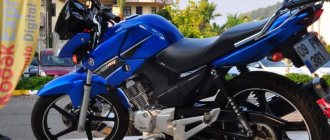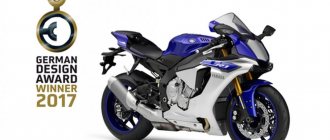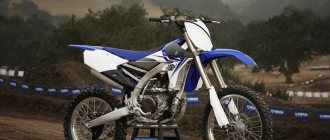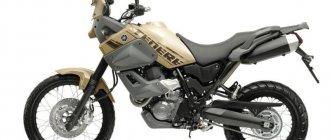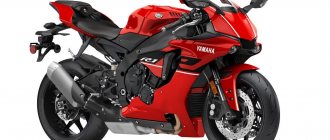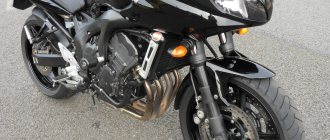| Yamaha YZF1000R Thunderace (1996-2001) |
Yamaha YZF1000R Thunderace sports motorcycle model
appeared in 1996, replacing the Yamaha FZR1000 model. The motorcycle was aimed at the Japanese export market of Europe and North America, but was also presented in small quantities at Japanese auctions. The Thunderace is the ancestor of the flagship Yamaha YZF-R1.
The Yamaha YZF1000R Thunderace was built on the basis of the engine from the FZR1000 (the updated version received a lighter crankshaft and pistons, as well as new larger carburetors with throttle position sensors), which did not produce more power, but due to modifications it became more torquey at medium speeds. The Thunderace 1000 frame is an aluminum Deltabox design, modified from the Yamaha YZF750R.
The main features of the Yamaha YZF1000R Thunderace include a sporty Deltabox aluminum frame, fully adjustable suspension, powerful Nissin Sumitomo 4-piston front brakes, a 20-liter fuel tank, a 5-speed gearbox and a 224 kg curb weight.
Yamaha's flagship sports model, the YZF-R1, was introduced to the world in 1998, although the Thunderace was available until 2001. Meanwhile, with the release of the R1, the Yamaha YZF1000R Thunderace began to position itself as a sports tourer. A similar situation occurred with the younger version of the Yamaha YZF600R Thundercat, which, after the release of the Yamaha R6, also began to be considered a sports touring model.
The main competitors of the Yamaha YZF1000R Thunderace in the class:
- Honda CBR900RR/919RR Fireblade
- Honda CBR1000F
- Kawasaki ZZ-R1100
- Suzuki RF900
Brief history of the model
- 1996 - start of production and sales of the Yamaha YZF1000R Thunderace model.
Model
: Yamaha Thunderace 1000 (Europe).
Factory designation
: 4SV1, 4VD1, 4VE1, 4VF1, 4VG1, 4WN1.
- 1997 - no significant changes.
Model
: Yamaha Thunderace 1000 (Europe, North America).
Factory designation
: 4SV3, 4VD2, 4VE2, 4VF2, 4WN2, 4YW1, 4YW2.
- 1998 - based on the Yamaha YZF1000R Thunderace, the first generation of the flagship Yamaha YZF-R1 appears. However, Thunderace continues to be produced in parallel.
Model
: Yamaha Thunderace 1000 (Europe).
Factory designation
: 4SV4, 4VD3, 4VD4, 4VF3.
- 1999 - model not produced.
- 2000 - no significant changes.
Model
: Yamaha Thunderace 1000 (Europe).
Factory designation
: 4SV5, 4VD5, 4VD6, 4VF4.
- 2001 is the last year of production.
Model
: Yamaha Thunderace 1000 (Europe).
Factory designation
: 4SV6, 4VD7, 4VD8, 4VF5.
Flaws
The model has no disadvantages, with the exception of one - the front fairing . Its design does not always withstand vibrations, so immediately after purchasing the bike it was recommended to strengthen the place where it is attached to the frame.
You'll have to remove the fairing.
And make an amplifier from a piece of pipe.
The other end of the pipe bends around the spider.
And it is secured with a bolt and nut.
The frame itself does not cause problems, but at high speeds the fastenings quickly became loose due to constant vibrations.
High oil consumption in the engine is not considered a disadvantage, although it is noted. But this problem occurs in almost any Japanese brand motorcycle.
and dignity
The Yamaha YZF1000R Thunderace is an excellent choice for professionals, but is by no means suitable for beginners.
Advantages of the model in terms of frequency of mention:
- Well adjusted brakes . “I’m slowing down with one finger.”
- Wide range of suspension settings. “It is apparently impossible to remove the purely sporting love of licking the canvas.”
- A high-quality gearbox, if you get used to it . “2 trips are enough.”
- Comfortable fit even for short people . “The windmill is just the right height for me.”
Specifications
Technical characteristics of Yamaha YZF1000R Thunderace:
| Model | Yamaha YZF1000R Thunderace |
| Motorcycle type | sport |
| Year of issue | 1996-2001 |
| Frame | aluminum Deltabox |
| engine's type | 4-cylinder, 4-stroke, in-line |
| Working volume | 1002 cm³ |
| Bore/Stroke | 75.5 x 56.0 mm |
| Compression ratio | 11,5:1 |
| Cooling | liquid |
| Number of valves per cylinder | DOHC, 5 valves per cylinder |
| Fuel supply system | carburetor, 4x Mikuni BDSR38 |
| Ignition type | TCI (digital) |
| Maximum power | 145.0 hp (107.0 kW) at 10,000 rpm |
| Maximum torque | 108.0 Nm (11.0 kg*m) at 8500 rpm |
| Clutch | Multi-disc in oil bath, hydraulic drive |
| Transmission | 5-speed |
| type of drive | chain |
| Front tire size | 120/70 ZR17 |
| Rear tire size | 180/55 ZR17 |
| Front brakes | 2 discs 298 mm, 4-piston calipers |
| Rear brakes | 1 disc 245 mm, 2-piston caliper |
| Front suspension | 48 mm telescopic fork (all adjustments), travel - 120 mm |
| Rear suspension | pendulum with monoshock absorber (all adjustments), stroke - 120 mm |
| Length | 2085 mm |
| Width | 740 mm |
| Height | 1175 mm |
| Wheelbase | 1430 mm |
| Minimum ground clearance (clearance) | 140 mm |
| Seat height | 790 mm |
| Acceleration 0-100 km/h (0-60 mph) | 2.96 sec[1] |
| Maximum speed | 264 km/h[2] |
| Gas tank capacity | 20.0 l (including reserve - 4.5 l) |
| Motorcycle weight (curb) | 224 kg |
Suspension from KYB
The suspension from KYB is installed with a softer one, 43mm front stays are fully adjustable, and the rear is a fully adjustable monoshock absorber. Braking lags behind other variants, with dual 320mm discs up front and a 220mm disc at the rear. Yamaha's Unified Braking System applies some of the front brake pressure to the rear caliper to improve stability. ABS does its best to prevent loss of traction in emergency situations, and also uses gyroscope data in the sensing unit to modulate ABS intervention levels, taking into account the reduced stopping power due to the laws of physics when cornering.
Race-tastic bikes get racing engines, and the R1S certainly doesn't disappoint. Technologically, this is the same Crossplane Concept motor that is used in other modifications, but with some nuances, such as steel washers instead of titanium, aluminum covers instead of lightweight magnesium and stainless steel as an alternative to titanium.
Yamaha R1S
Reviews
Reviews about Yamaha YZF1000R Thunderace:
Expand Collapse
What a great sports tour! Very powerful, with its 142 fillies it accelerates very easily. 100km/h in 1st gear? No problem! The abundance of plastic makes you think about its repair. I had a chance to ride this one a little 3-4 years ago. At first, my rear wheel often skidded. I decided to shoot in a straight line once and was surprised that I couldn’t accelerate more than 140-150, although there was a feeling of enormous speed. It turned out that it was an “American”, i.e. The speedometer was digitized in miles.
Very powerful and very flexible sport-tourer. Large, comfortable, heavy.
Of the minuses I would write:
- most likely it will consume oil (it is for these Yamaha engines that they are nicknamed oil guzzlers)
— A 5-valve circuit requires frequent valve clearance monitoring or there will be no compression
I took an ace in the fall, drove about 1000 km until the cold weather and so far only positive emotions. It drives very well from the bottom, which is good in traffic jams, it also handles perfectly. The speedometer was driving 280 km/h, there was even a reserve and it picks up this speed quickly and confidently .By the way, I didn’t add oil, I kept an eye on the level after every trip. They say that the oil gluttony also depends on what kind of oil you use. The plastic is well cut, doesn’t make it look bad anywhere, the suspensions are excellent. In short, you can ride on it for long distances, and you can fire it up like on a sports car
It drives very well from the bottom, which is good in traffic jams, it also handles perfectly. The speedometer was driving 280 km/h, there was even a reserve and it picks up this speed quickly and confidently .By the way, I didn’t add oil, I kept an eye on the level after every trip. They say that the oil gluttony also depends on what kind of oil you use. The plastic is well cut, doesn’t make it look bad anywhere, the suspensions are excellent. In short, you can ride on it for long distances, and you can fire it up like on a sports car
An intermediate model between the FZR1000 and R1, it was conceived as a sportbike. It turns out that it’s not a “tourist”, but according to reviews it’s good for long-distance driving)))
I was also interested in this model when I wanted to buy a bike. I read a lot of reviews about it, and they are all mostly positive.
What I liked about the ACE and what I still like is its versatility, it can go long distance and kick the ass of P1 fans on the Ring. And I also respect him, yes, I really respect him, because in 3 years there has never been a time when I inserted the key into it and drove away from the parking lot in a car. I haven’t even removed the battery from it once in 3 years, neither in winter nor in summer, I wanted to go for a ride, key to start and go, in a word, I respect reliable equipment. I have driven quite a bit on it, almost 20,000 km, so I can speak for it. I won’t talk about how lucky a liter is…
The best sportbike of both worlds - Yamaha YZF-R1 (2020): test drive - city and highway
It’s been a while since we spoiled you with fresh test drives of new motorcycles, but it looks like there will be a lot of them this year. And I want to start with it - with a legend, with the wet dream of anyone who has at least once dreamed of a sports bike - with the latest generation Yamaha YZF-R1: I got it for quite a long time and managed to test it both on the track and on public roads use. And now I don’t know what impressed me more!
MOTOGONKI.RU, April 9, 2022 — Obvious factors around the world are spurring the popularity of motorcycle track days. Firstly, the tightening of the screws in traffic regulations and the abundance of speed cameras on highways. Secondly, the traffic is terrible - you won’t be able to get away like before.
Test drive Yamaha YZF-R1 (2020)
If you think that this is only true in Russia, but no – everywhere, throughout Europe. That's why Germany, despite having the best motorway network in the world, also has the widest selection of racing tracks.
Where can I gas?
I want to say seriously, move to America... but there may be troubles on a different scale there. There are many roads in the USA. There are many of them and some offer the opportunity to drive in splendid isolation, completely without traffic. But the first thing that surprises you in America is the terrible quality of the coating, as well as the abundance of sand and dust where you don’t expect it at all. Everything, of course, is not as neglected as on the secondary roads of Italy and France, especially in rich agricultural regions, but in some places it is even worse. Precisely because the hold can disappear suddenly, where you least expect it. That's why Americans love track days so much.
But now in Russia there is a place to go racing on weekends—your choice.
Test drive Yamaha YZF-R1 (2020)
Moscow Raceway has been a Mecca for sportbikers since 2012, and the circuit is busy with track days almost every weekend. Kazan-Ring, and halfway to it - NRing. In mid-June 2022, the updated ADM Raceway fully opened with very good quality asphalt and low prices for evening training sessions. Finally, in August, the Igora Drive circuit near St. Petersburg was fully operational - the first full-fledged competitor of MRW with a plan to homologate the track for MotoGP and World Superbike.
What is all this for?!
Manufacturers continue to compare themselves with the horses and power output of their flagship models, but it is impossible to realize “this is all” anywhere except on the track! And even on the track, the limits of the production models are reached... already in 4th gear. Therefore, an obvious trend formed itself in 2016, when Honda Motor Co. presented at INTERMOT the updated Honda CBR1000RR Fireblade SP: a motorcycle that was originally created for the track, but became ultra-comfortable on the way to the track.
All modern superbikes are created for people who come to track days under their own power, on the same motorcycles, ride, and then go home without even changing tires
This is exactly what the latest generation Yamaha YZF-R1 is.
Test drive Yamaha YZF-R1 (2020) - the wet dreams of any motorcyclist
I did not carry the R1 with me on a trailer, but decided to drive it all - the city, freeways, track, cut asphalt and the rigors of P-class roads, without making any changes to the settings and stock configuration. The result was a test similar in its parameters to the test drive of the 2022 Honda CBR1000RR Fireblade SP. But with completely different sensations.
The sensations are amazing and hard to imagine when sitting on a radical superbike with a 200 hp engine.
YZF-R1 is ideal for a person of average height (172 to 182 cm):
First of all, it's the ergonomics of the seat - you immediately become part of the motorcycle!
Test drive Yamaha YZF-R1 (2020)
In the city
For city driving, I adopted a "on the tank" position to increase understeer. I’ve already heard from other testers, including Western colleagues, that the R1 offers a completely different perspective from the rider’s seat, and I understood what they mean after driving the first 20 km through traffic-filled Friday Moscow.
Test drive Yamaha YZF-R1 (2020)
Sitting in "city mode", you hang over the tank and dashboard so that you can only see the front of the bike. All attention and concentration is on the road and traffic, and only a little on the mirrors. The mirrors on the R1 are a thing in themselves. In them you can see just a little on the sides, most of the picture is covered by the shoulders. No matter how I twisted it, they didn’t show the mirror anymore. I had to turn my head. The instrument panel practically disappears from view.
But you get the feeling that this motorcycle can get through anywhere without slowing down. This effect is a consequence of the landing: it seems that if the shoulders go through, the rest will definitely get through! Riding in traffic on the YZF-R1 is too easy. The only “but”: drivers of SUVs and Gazelles simply do not see you in the mirrors. But on the highway, the light from the LED headlights is enough to disperse the crowd from afar. On country roads, everyone tries to miss the “blue bullet”, even if you are not going anywhere.
Test drive Yamaha YZF-R1 (2020)
This gives rise to a strange feeling: you are riding in the flow or with the flow, i.e. according to the rules, but motorists and motorcycles passing by stupidly do not understand you - “what is it doing here?”
It is enough to drive 20 km/h faster than the flow, and everything falls into place, all the doors and gates open.
Test drive Yamaha YZF-R1 (2020)
At the same time, on the R1 it is not at all difficult to stay within the traffic rules without violating the speed limit. The engine power is enough to move off smoothly, even from first or second gear. Comfortable driving on the YZF starts from 10 km/h. Controlling the speed from 60 to 100 km/h is more difficult: in 2nd gear it is not easy to keep the motorcycle within 100 km/h, and in 3rd gear the effect of Engine Braking (EB) is too active. The main feeling from the new engine is that it is not harsh.
When you set the mode to suit you with minimal power, you will feel great in the city! EB handles braking on the rear wheel, so it is enough to control the front wheel, and then only in the case of more or less emergency braking.
Test drive Yamaha YZF-R1 (2020): these brakes will stop a whole train!
Braking!
What you need to immediately remember and keep in mind: the YZF-R1 brakes as quickly as it accelerates. The active braking of a motorcycle on the freeway several times became unexpected - and not a very pleasant surprise for the nimble “racing drivers” who were trying to follow me. Yamaha's control electronics package includes a rear wheel lift control unit that receives data directly from the inertial unit (IMU) and instantly detects dangerous situations with uncontrolled stoppies. The rear wheel comes off when braking in front of traffic lights, just for fun – as much as you like! But during sharp braking on a straight line, for example, from 150 to 40, when a rollover effect may occur, the ABS actuators are activated, the pressure in the brake line decreases slightly, and the motorcycle stabilizes. Equipped with electronic suspension, the YZF-R1M also adjusts the shock absorbers to better distribute load between the front and rear ends for safer braking. This is not all the R1 features related to smart braking. They will be discussed below.
Driving around the city at the pace of traffic is not at all annoying
Sitting on a radical sportbike, you are always in tension: the seating position is in any case such that you will rest your hands on the clip-ons, so the load comes to your wrists and shoulders. But the Yamaha R1 has plenty of room to move around in the saddle, so you can get into any position. For the city, the only comfortable position is “on the tank”.
Test drive Yamaha YZF-R1 (2020): regular model with KYB fork and full set of settings
The Yamaha chassis is a fairy tale, just a revelation! If Honda tried to create the perfect Road & Track bike in 2022, Yamaha did it even better. The YZF-R1 feels equally confident both on freshly laid, still warm asphalt, and on freshly removed asphalt, full of crumbs and dust. The weak point of the motorcycle is longitudinal irregularities with sharp edges. Driving even on 5-centimeter longitudinal sections of asphalt is a special operation if you even a little value a motorcycle worth 1.5 million rubles.
According to tradition, the motorcycle was sent into battle against superior enemy forces in the form of the laziest road services in the world - somewhere on the border of the Moscow and Tver provinces. The 2017 Fireblade SP test there was a real pain, the speed on the 40 km long P-108 section dropped to 60 km/h.
And nothing like that with Yamaha!
Horizontal flaws and irregularities still hit the pilot in the butt, but the stability that the standard KYB gives allows you to go through the same places at a much higher speed: where on the CBR1000RR I reduced to “60”, on the YZF-R1 I flew at “90” .
Test drive Yamaha YZF-R1 (2020): even if the asphalt is chewed, there will be no problems with the R1
I experienced a pleasant shock from the YZF-R1 chassis when I arrived in Krasnogorsk. Exactly one day before the start of the test, the asphalt rodents chewed up all the streets and went to rest, leaving the work unfinished for another week.
Convex markings between rows? It doesn't exist for the YZF-R1. Ruts in the left lane on the M9? Mild restlessness
#Tyzhsportbike should be tough and dangerous - there was doubt. But driving through the first cut completely changed my attitude towards the R1: the chassis handled the bumps perfectly, I didn’t notice them. The motorcycle did not buck or swerve during the entire week of testing.
On the freeway
The first thing I remembered when I got out on the M9 was that I had a completely unsuitable helmet for such a motorcycle. The Blauer Sky flip-up is perfect for all but two motorcycles: on the BMW S 1000 RR and Yamaha YZF-R1, it will play all the funniest tunes! Another flip-up feature that is completely unsuitable for use on the R1 is the heavy and too massive visor.
Test drive Yamaha YZF-R1 (2020)
This was not the case with the Fireblade in 2022, because the Honda's ergonomics are different, and the standard glass creates a better aerodynamic bag for an average-sized pilot. The Yamaha requires you to lie down on the tank.
But in my case, this radically deteriorated my visibility. The solution is simple: just put on the simplest “integral” - and go into battle!
For a more comfortable fit behind a small windshield, Yamaha makes a recess in the front of the tank where you can rest your chin: the recess allows you to position part of the helmet below the filler neck, so that you completely merge with the motorcycle.
To achieve maximum speeds, one way or another, you will have to lie down on the tank all the way and merge with the motorcycle
In Russia there is not yet a high-speed racing track where you can accelerate to 300+ on a standard motorcycle. Not even all the lightweight superbikes from RSBK are capable of doing this on the back straight of Moscow Raceway! Therefore, M9 and M11 are probably almost the only chance to see the coveted “299” on the speedometer within a radius of 500 km from Moscow.
Test drive Yamaha YZF-R1 (2020): should we take it for a long drive?..
The main feeling of riding the Yamaha YZF-R1 at speeds of “240+” is that it is simply amazingly stable! The feeling of speed disappears somewhere after 170. Therefore, I would not recommend repeating such experiments on the additional stage. The most dangerous thing about them is the difference in speed with other road users: they don’t even realize...
R1 is a sprinter, not a marathon runner
But the fact is that the R1 allows you to go fast enough for a long time, and you will not feel tired. There is even a plus in the fact that the tank will last for 140-150 km: you will have time to warm up at a gas station while the closest pursuer has traveled at least 25 km.
Test drive Yamaha YZF-R1 (2020)
But this will not allow you to beat the record of the Honda CRF1000L Adventure Sport in achieving an average speed of 199 km/h on the route: where an adventure motorcycle makes one pit stop (at the same average speed), the R1 will have to make three, which will not help improve the figure . Unfortunately, this time it was not possible to conduct an experiment on this topic and provide some clearer proofs.
Test drive Yamaha YZF-R1 (2020): to reach a speed of 200+ you need to lie down on the tank
Unlike many comfortable sports tourers, there is no prostration on the open highway. The feeling of speed is absolutely clear, somewhere up to 180 km/h. There is no such thing that you would like to go, say, “130”, but the speedometer is already “180”, and you did not notice when you picked up the pace.
Interesting point: do not try to look for a fuel level indicator on the control panel, it is not there!
In the case of the R1, this would be an unforgivable omission on a long trip, especially on an unfamiliar road: do not try to look for a fuel level indicator on the control panel, it is not there!
Test drive Yamaha YZF-R1 (2020)
Yamaha YZF-R1 is not about the amount of fuel consumed. Moreover, the motorcycle provides the pilot with simply comprehensive information about this. You can set up a demonstration of three indicators at once: average consumption, instantaneous consumption, and also (the most important) how much gasoline the motorcycle has already consumed after refueling.
Test drive Yamaha YZF-R1 (2020): everything should be elegant in a luxury motorcycle!
A full tank holds 17 liters of AI-95. The low level indicator lights up when there is 3 liters left in the tank. At the first departure, at a mixed pace (from 0 to ∞) - and before the indicator was constantly on, I walked 190 km, to the next gas station it turned out to be 25 km - no worries. During the urban driving cycle, the consumption of the 998 cc in-line engine is “white and fluffy” - 5.8-6 l/100 km. But if you raise the speed above 7000 rpm... or on the track...
Why didn't they add a fuel level indicator? Now is this redundant? It helps to know that 3 liters of reserve is enough for 40-50 km
In fact, having left the next day “just for a ride”, without any malicious intent, I managed to drive 235 km on 15 liters, which according to statistics is 6.4 l/100 km. It all depends solely on your mood and driving style. Do you know that this is exactly what is written in every “User Manual”? Who even reads them!..
Test drive Yamaha YZF-R1 (2020): Street Mode / Track Mode
And yet, now this will be an integral part of the procedure for owning a modern motorcycle...
Continuation:
all the nuances of working with electronics, Track Mode and preparing the Yamaha YZR-R1 for the track.
Test drive Yamaha YZF-R1 (2020)
Yamaha R1S engine
A four-cylinder engine with a cylinder size of 79 mm by 50.9 mm, the volume of which totals up to 998 cc. See: While the R1S engine is slightly different, it takes longer to rev due to the increased weight of the connecting rods. Overall power remains just as sweet, though, a staggering 200 horsepower at 13,500 rpm, so yes, it's still as good as the less street-friendly variants.
Switching driving modes is also preserved here and is controlled electronically. That is, in fact, this modification retains all the useful functions of the R1 version, with the exception of the quickshifter. Even having reduced the track weight on this version, it still remains more suitable for racing than its competitors from other manufacturers. Therefore, I had to look for another sportbike and compare them; the BMW S 1000 RR immediately became a likely candidate.
BMW S 1000RR
BMW S 1000 RR
BMW keeps pace with the progress as the suspension has electronic, automatic dynamic damping settings, while on the Yamaha the suspension is fully adjustable, but with knobs. The BMW S 1000 RR engine is only one cubic meter larger than the Yamaha and is 999 cc. See, and the power figures are similarly close at 199 horses, but the Yamaha engine felt more flexible throughout the entire rev range.




